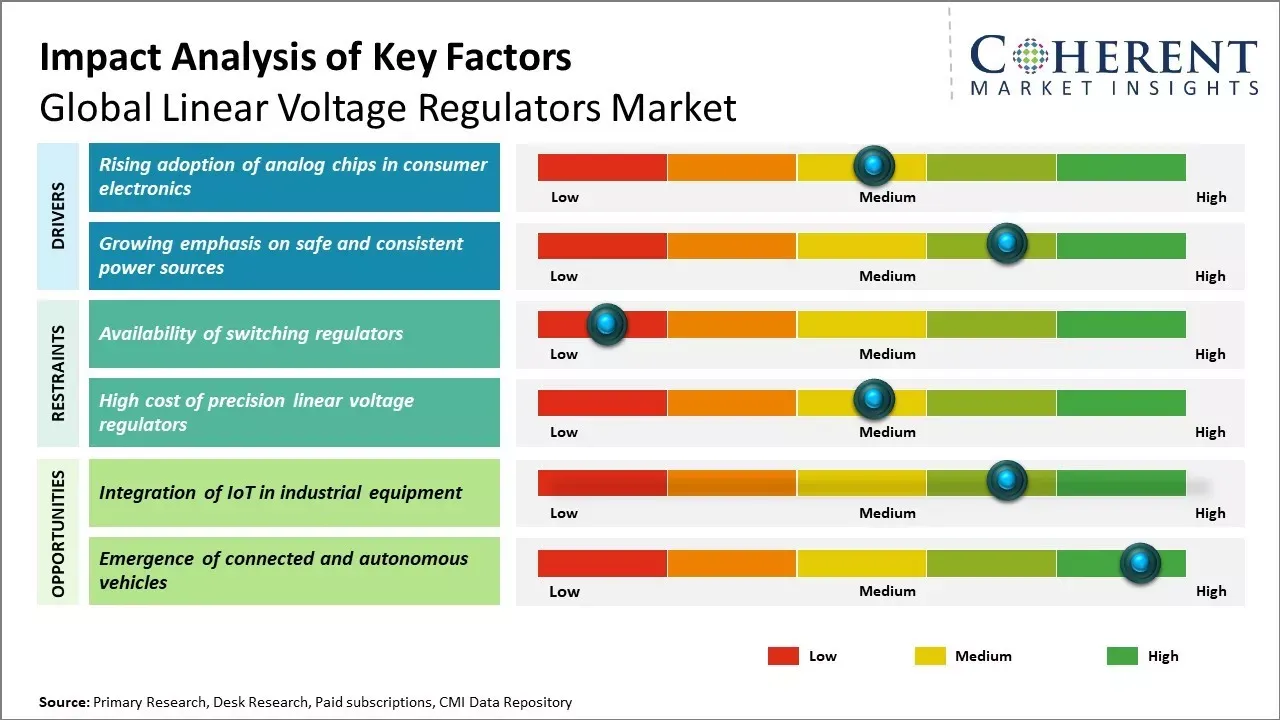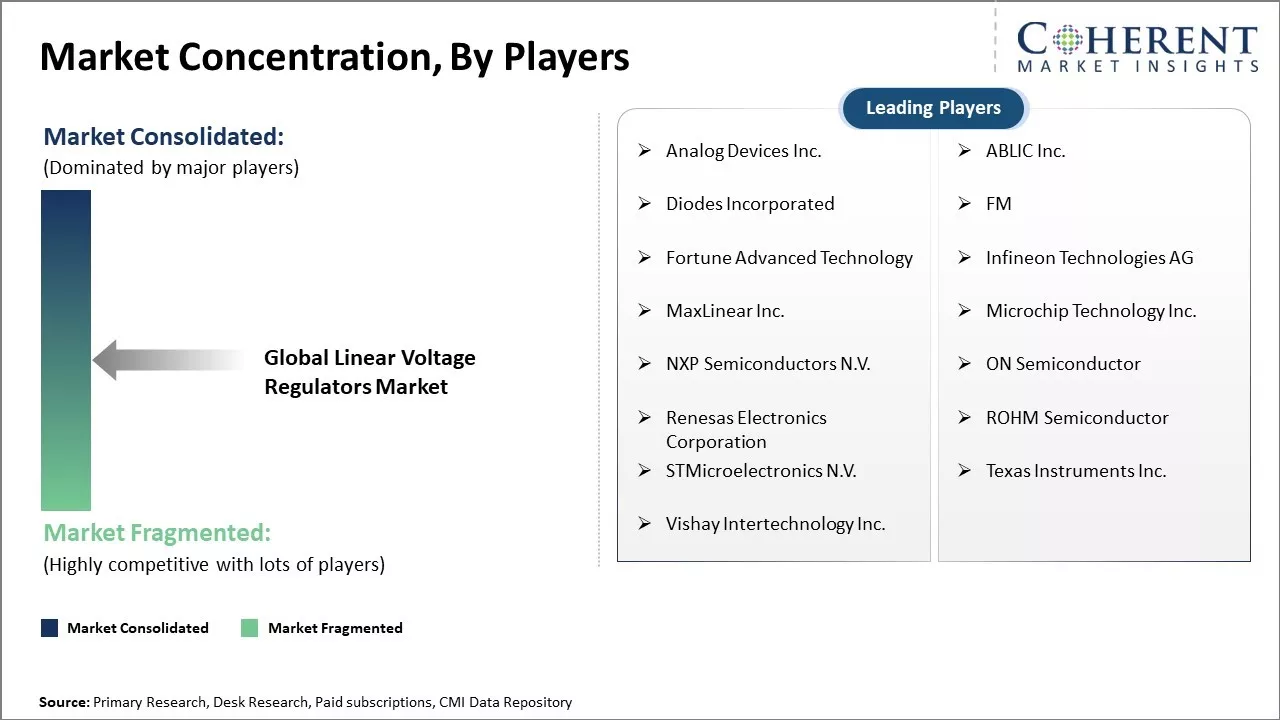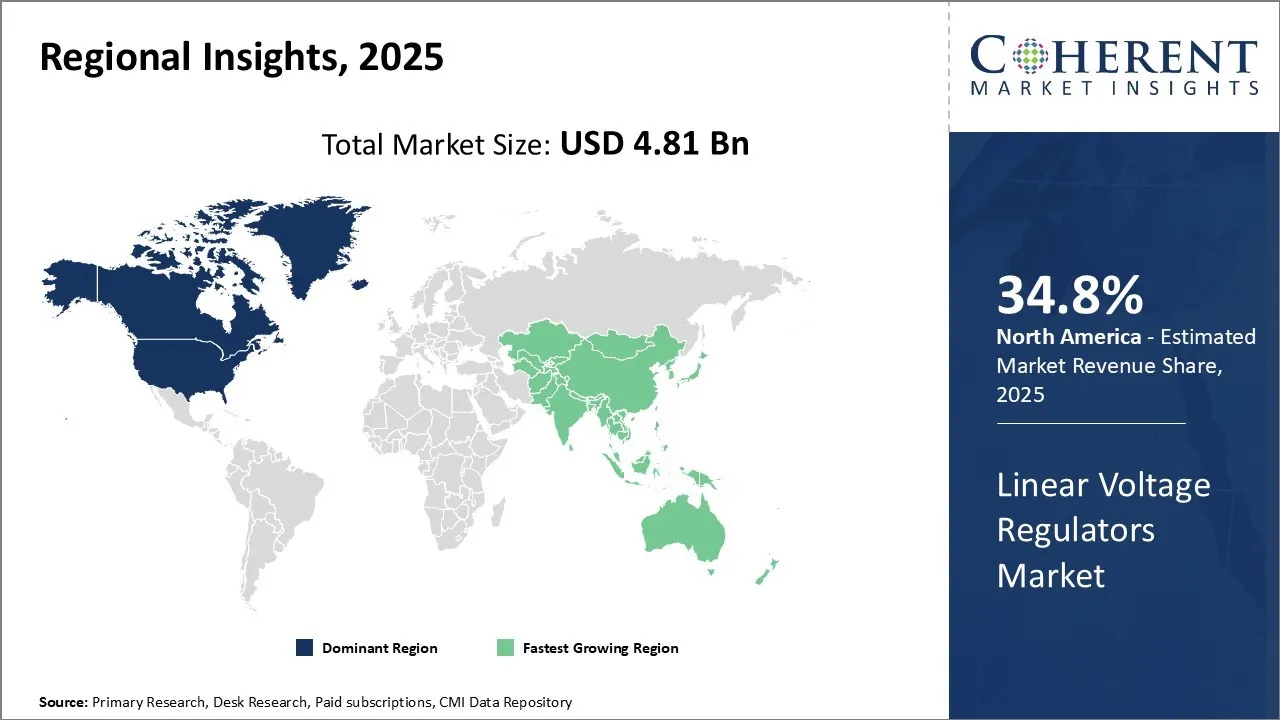Linear Voltage Regulators Market Analysis & Forecast: 2025-2032
The global Linear Voltage Regulators Market size is estimated to be valued at USD 4.81 Bn in 2025 and is expected to reach USD 8.30 Bn by 2032, exhibiting a compound annual growth rate (CAGR) of 8.1% from 2025 to 2032.

To learn more about this report, Download Free Sample
Key Takeaways
- By Type, the Low Drop-Out (LDO) segment is projected to account for the largest linear voltage regulators market Share of 34.9% in 2025, driven by their optimum efficiency, thermal performance, and design flexibility.
- By End User, the Automotive segment is expected to hold the leading share of 39.7% in 2025, supported by the rising integration of linear voltage regulators in electric vehicles and advanced driver-assistance systems (ADAS) requiring stable and precise voltage regulation.
- By Region, North America is anticipated to dominate the market with a projected share of 34.8% in 2025, underpinned by robust investments in automotive electronics, consumer devices, and industrial automation, along with a strong base of semiconductor manufacturers.
Market Overview
The linear voltage regulators market forecast is expected to witness positive growth over the period owing to the rising demand for mobile computing devices and increasing adoption of linear voltage regulators in automotive applications. Linear voltage regulators are widely used in consumer electronic devices such as smartphones, laptops, personal computers, and industrial automation equipment, among others due to their attributes such as stability, noise rejection, and simplicity. Advancements in telecommunication infrastructure and surge in the demand for consumer electronics are further expected to fuel the demand for linear voltage regulators.
Current Events and Its Impact
|
Event |
Description and Impact |
|
Global Semiconductor Supply Chain Instability |
|
|
Economic Trade Policies and Tariff Adjustments |
|
|
Technological Advancements in Power Management |
|
Uncover macros and micros vetted on 75+ parameters: Get instant access to report
Market Concentration and Competitive Landscape

To learn more about this report, Download Free Sample
Rising adoption of analog chips in consumer electronics
The proliferation of various consumer electronics like smartphones, laptops, tablets, handheld gaming consoles, and smart home appliances is very rapid worldwide. All these devices have power management systems and circuitry which require integration, or at the very least, interfacing with Linear Voltage Regulators (LVR). Moreover, the ongoing trends in the electronics industry, especially in consumer electronics, increases their integration in a single unit, increases the need for consumer products to have a precise and stabilized power supply further adding to preexisting system complexity.
Having high accuracy and stability features enables LVRs to meet power requirements. Every modern electronic device makes use of a number of linear analog integrated circuits and devices which require a regulated power supply and LVRs serve this purpose very well. LVRs designed for use in small electronic devices such as smartphones are particularly effective at meeting the requirements of these devices due to their efficiency with handling small loads under].
For example, in november 2020 ABLIC, a Japan based company engaged in the design, manufacture and market of analog semiconductor products launched the multifunctional all-in-one low-dropout LDO linear regulators (S-19516, S-19517, and S-19519 series). These devices have been developed to improve the functional safety for automotive applications by adding powersuupply voltage monitoring (reset) and operation monitoring (watchdog timer) features.
Growing emphasis on safe and consistent power sources
With the widespread integration of electronics in various critical infrastructure and industrial sectors, the need for robust and reliable power sources has increased tremendously. Functions such key safety systems, medical devices, automated industrial equipment, communication networks, and various monitoring systems rely on continuous power supply to perform their operations smoothly. Any fluctuation or spike in the power source can disrupt the performance of such systems or even cause failures.
Linear voltage regulators ensure steady and clean output voltage regardless of fluctuations in the input voltage and variations in load current. Their fast response time and tight regulation capabilities make them a preferred solution for applications requiring consistent power. Furthermore, safety certifications are an important consideration for equipment used in the infrastructure, transportation, healthcare, and other industries.
Linear regulators provide cost-effective solutions for meeting various global safety standards. The emergence of new technologies such as the Internet of Things (IoT) and Industry 4.0 is further driving the need for robust power management infrastructure, propelling the demand for linear voltage regulators in industrial applications going forward.
Market Opportunities
- Integration of IoT in industrial equipment
The convergence of industrial internet of things (IIoT) technologies and operational equipment offer a major opportunity for the linear voltage regulators market globally. As industrial machinery and assets become increasingly connected and intelligent, there will be higher demand for voltage regulation components that can reliably operate in harsh industrial environments while enabling new IoT-enabled use cases.
Linear voltage regulators installed in IIoT devices can help optimize asset performance and utilization. Equipment integrated with sensors, networking capabilities as well as voltage regulation can generate and transmit operational data in real-time. This facilitates predictive maintenance by enabling remote equipment monitoring. Manufacturers can track machine runtimes, failures, and downtimes.
Linear Voltage Regulators Market Insights, By Type
The low drop-out segment, often referred to as LDO regulators, have seen rising popularity, and are expected to account for 34.9% of the Linear Voltage Regulators Market Demand share in 2025 due to their advantages over other types. LDO regulators maintain a constant output voltage very close to the input even when there is a small difference between input and output levels. This low dropout voltage characteristic makes them highly efficient and able to function properly with low input-output differentials.
Their high efficiency is a major driver of their increased usage. As electronic devices become more compact and portable, power efficiency is a huge priority for manufacturers and consumers alike. Being able to maintain stable power outputs while minimizing losses translates directly to longer battery life for mobile gadgets. LDO regulators help maximize the usable life that can be extracted from a limited battery capacity.
Linear Voltage Regulators Market Insights, By End User
Within the end user segment, the automotive segment is expected to claim 39.7% share in 2025 of Linear Voltage Regulators Market Growth. Modern vehicles contain dozens of electronic control modules that precisely manage an array of complex systems. Sustained innovation in driver safety technologies like advanced driver-assistance systems has especially bolstered regulator demand from the automotive industry.
Features such as adaptive cruise control, automatic emergency braking and lane keeping assistance incorporate sophisticated sensors that require robust voltage regulation to function reliably. As more cars add these types of semi-autonomous driving modes, the need for voltage regulators able to withstand automotive-grade temperature ranges and vibrations rises in step.
Regional Insights

To learn more about this report, Download Free Sample
North America Linear Voltage Regulators Market Analysis and Trends
North America is projected to lead the global Linear Voltage Regulators Market outlook, accounting for an estimated 34.8% market share in 2025. This leadership stems from the strong presence of established electronics manufacturers and semiconductor fabrication units, particularly in the U.S., which hosts key industry players such as Texas Instruments, Analog Devices, ON Semiconductor, and Maxim Integrated.
The region benefits from a mature and expansive domestic market for consumer electronics—including computers, smartphones, and household appliances—ensuring stable and continuous demand for linear voltage regulation solutions. Government initiatives aimed at fostering research and innovation in electronics and semiconductor technologies further strengthen North America’s business environment.
Asia Pacific Linear Voltage Regulators Market Analysis and Trends
Asia Pacific is expected to emerge as the fastest-growing region in the global Linear Voltage Regulators Market value during the forecast period. Rapid industrialization, expanding manufacturing capabilities, and a growing middle-class consumer base across key economies such as China, India, South Korea, and Japan are driving regional market expansion.
The availability of low-cost, skilled labor has attracted both multinational corporations and domestic electronics brands to establish extensive production facilities within the region. Asia Pacific’s robust export performance in the electronics sector has reinforced its role in the global supply chain, encouraging many linear voltage regulator manufacturers to develop comprehensive distribution and supply networks.
Dominating Countries in the Linear Voltage Regulators Market
United States Linear Voltage Regulators Market Analysis and Trends
The U.S. continues to dominate the North American Linear Voltage Regulators Market trends, supported by its well-established semiconductor and electronics manufacturing ecosystem. The presence of major voltage regulator innovators and fabricators underpins the country’s leading position. Government support for R&D and a large consumer electronics market fuel consistent demand for linear voltage regulation technologies. Ongoing advancements in design and manufacturing processes ensure the U.S. remains at the forefront of voltage regulator innovation and adoption.
India Linear Voltage Regulators Market Analysis and Trends
India is emerging as a key growth market within Asia Pacific, driven by rapid urbanization, increasing disposable incomes, and expanding electronics manufacturing capabilities. The country’s burgeoning middle-class population is contributing to rising demand for consumer electronics, thereby boosting the linear voltage regulators market. Government policies aimed at strengthening domestic electronics production and attracting foreign investments are expected to accelerate growth.
Market Report Scope
Linear Voltage Regulators Market Report Coverage
| Report Coverage | Details | ||
|---|---|---|---|
| Base Year: | 2024 | Market Size in 2025: | USD 4.81 Bn |
| Historical Data for: | 2020 To 2024 | Forecast Period: | 2025 To 2032 |
| Forecast Period 2025 to 2032 CAGR: | 8.1% | 2032 Value Projection: | USD 8.30 Bn |
| Geographies covered: |
|
||
| Segments covered: |
|
||
| Companies covered: |
Analog Devices Inc., ABLIC Inc., Diodes Incorporated, FM, Fortune Advanced Technology, Infineon Technologies AG, MaxLinear Inc., Microchip Technology Inc., NXP Semiconductors N.V., ON Semiconductor, Renesas Electronics Corporation, ROHM Semiconductor, STMicroelectronics N.V., Texas Instruments Inc., and Vishay Intertechnology Inc. |
||
| Growth Drivers: |
|
||
| Restraints & Challenges: |
|
||
Uncover macros and micros vetted on 75+ parameters: Get instant access to report
Analyst Viewpoint
- The global linear voltage regulators market is poised to witness steady growth over the forecast period. The widespread use of linear voltage regulators in electronics devices for stable power supply will drive demand. The increasing integration of linear regulators in smartphones, laptops, and other portable devices for efficient power management is a key growth driver. The market will benefit from the rising demand for advanced technologies such as Android/iOS smartphones, LED lighting, and smart home devices.
- However, high competition from switching voltage regulators may limit the growth of the linear voltage regulators market to some extent. Switching regulators are gaining traction due to their high efficiency compared to linear regulators. Rising power consumption worldwide is also prompting manufacturers to focus on more energy-efficient solutions. Fluctuating costs of raw materials may increase the overall production cost of linear voltage regulators.
Linear Voltage Regulators Market Key Developments
- On April 17, 2024, STMicroelectronics introduced two new voltage regulator series, LDH40 and LDQ40, designed for automotive and industrial applications. These regulators have the ability to start up with an input voltage as low as 3.3V and can operate with an input voltage of up to 40V. Additionally, they feature low quiescent current, making them efficient power management solutions.
- In May 2022, Toshiba Electronic Devices & Storage Corporation ("Toshiba") launched the TCR1HF series of LDO regulators that deliver high voltages, a wide input voltage range, and the industry’s lowest stand-by current consumption. Shipment of the first three products in the new series, “TCR1HF18B,” “TCR1HF33B,” and “TCR1HF50B,” which offer output voltages of 1.8V, 3.3V, and 5.0V, respectively.
- In December 2020, Ricoh Electronic Devices Co., Ltd., a Japan-based company, introduced a new voltage regulator called R1526. This regulator is capable of operating with an input voltage of up to 42V and can deliver an output current of 300mA.
Market Segmentation
- Type Insights (Revenue, US$ Bn, 2020 - 2032)
- Series
- Shunt
- Low Drop-out
- Standard
- End User Insights (Revenue, US$ Bn, 2020 - 2032)
- Automotive
- Residential
- Industrial
- Automotive
- Regional Insights (Revenue, US$ Bn, 2020 - 2032)
- North America
- U.S.
- Canada
- Latin America
- Brazil
- Argentina
- Mexico
- Rest of Latin America
- Europe
- Germany
- U.K.
- Spain
- France
- Italy
- Russia
- Rest of Europe
- Asia Pacific
- China
- India
- Japan
- Australia
- South Korea
- ASEAN
- Rest of Asia Pacific
- Middle East & Africa
- GCC Countries
- Israel
- South Africa
- Rest of Middle East & Africa
- Key Players Insights
- Analog Devices Inc.
- ABLIC Inc.
- Diodes Incorporated
- FM
- Fortune Advanced Technology
- Infineon Technologies AG
- MaxLinear Inc.
- Microchip Technology Inc.
- NXP Semiconductors N.V.
- ON Semiconductor
- Renesas Electronics Corporation
- ROHM Semiconductor
- STMicroelectronics N.V.
- Texas Instruments Inc.
- Vishay Intertechnology Inc.
Sources
Primary Research interviews
- Product Managers from Linear Voltage Regulator Manufacturing Companies
- Senior Engineers from Semiconductor Companies
- Regional Managers from Electronic Component Distributors
- Analysts from Technology and Electronics Research Firms
- Others
Databases
- IEEE Xplore
- Semiconductor Industry Association Database
- Bloomberg Intelligence
- Others
Magazines
- Electronics Weekly
- EE Times
- Power Electronics Magazine
- Electronic Design
- Others
Journals
- IEEE Transactions on Power Electronics
- International Journal of Electronics and Electrical Engineering
- Journal of Semiconductor Technology and Science
- Others
Newspapers
- The Economic Times
- Business Standard
- Financial Times
- Nikkei Asia
- Others
Associations
- Semiconductor Industry Association (SIA)
- IEEE Power Electronics Society
- International Electronics Manufacturing Initiative (iNEMI)
- Electronic Components Industry Association (ECIA)
- Others
Public Domain sources
- Ministry of Electronics and Information Technology (Govt. Portals)
- United States Patent and Trademark Office
- European Semiconductor Portal (EU Public Domain)
- World Bank Annual Reports and Publications
- Others
Proprietary Elements
- CMI Data Analytics Tool
- Proprietary CMI Existing Repository of information for last 8 years
*Definition: The global linear voltage regulators market involves the manufacturing, distribution, and sales of linear voltage regulator integrated circuits (ICs) worldwide. These regulators help maintain stable output voltages for electronic circuits and components despite fluctuations in input voltages or loads. They are commonly used in various devices and equipment needing a regulated power supply that produces a fixed voltage output from a fluctuating DC input voltage. Some key applications include computers and peripherals, telecommunication systems, portable devices, and industrial equipment.
Share
Share
About Author
As an accomplished Senior Consultant with 7+ years of experience, Pooja Tayade has a proven track record in devising and implementing data and strategy consulting across various industries. She specializes in market research, competitive analysis, primary insights, and market estimation. She excels in strategic advisory, delivering data-driven insights to help clients navigate market complexities, optimize entry strategies, and achieve sustainable growth.
Missing comfort of reading report in your local language? Find your preferred language :
Transform your Strategy with Exclusive Trending Reports :
Frequently Asked Questions
EXISTING CLIENTELE
Joining thousands of companies around the world committed to making the Excellent Business Solutions.
View All Our Clients

